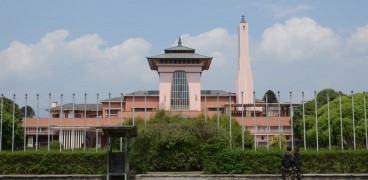Rara National Park is known as Nepal’s smallest national park that lies in the Himalayan region. The main feature of the protected area is the Rara Lake which lies at the height of 2,990 m above sea level.
The wildlife reserve is protected by the jurisdiction of the Department of National Parks and Wildlife Reservation in association with the Nepalese Army. The article discusses all the major features of the Rara National Park.
Where is Rara National Park?
Established in 1976 the conservational area covers an area of 106 km square and lies in the Jumla and Mugu districts in the far north-western end of Nepal.

Rara National Park's Natural Beauty
The main purpose for the establishment of this small national park was to ensure the protection of the unique flora and fauna found in the Humla-Jumla region.
How can we reach Rara National Park?
We take a flight from Kathmandu-Nepalgunj and then to Jumla. It takes about 2.5 days from Jumla on foot, or you can also walk for ten days from Surkhet.
The trek to Rara National Park passes through remote countryside lying close to the Tibetan border.

Rara National Park Trekking Adventure
Since there are no accommodations inside the park, trekkers are advised to have their arrangements made via trekking agency before leaving for the park. Visitors must be self-sufficient with their supplies, including medical, as there are no health posts in the area.
When is the best time to visit Rara Lake?
The best time to visit the conservational area is during the months of spring (March, April, and May), summer (May-August), and autumn (September - November).
Landscape of Rara National Park
The national park ranges from 2,800 m to 4,039 m in elevation. It is surrounded by mountain peaks like Chuchemara on the south and Ruma Kand and Malika Kand on the north.
Rara Lake
Rara Lake also known as Mahendra Tal, is Nepal’s most prominent and deepest freshwater lake lying in the cradle of Nepalese Himalayan. The water body lies at an altitude of 2,990 m (9,810 ft) above sea level and covers an overall area of 10.8 km sq.

Peaceful Meditation in Rara Park
The depth of the lake is calculated to be 167 m and extends to over 5.1 km in length and about 2.7 km in width. The water from the oligotrophic lake drains into the Mugu Karnali River flowing through the Nijar River.
A temple of Thaku Baba is located in the south-east corner of the lake. Rumours have it that the God Thakur shot an arrow making a passage for the lake, thereby reducing the damage of the flood.
Vegetation in RNP
The plants in the wildlife reserve have been classified into two categories; high temperate vegetation and subalpine. Botanists have recorded about 1070 species of flora in the Rara National Park.
The forests in the sub-alpine region of the park are ladened with different species of trees like fir (Abies), Rhododendron (Rhododendron arboretum), birch (Betula), and brown oak (Helicia glabriflora).
The vegetation below 3,200 m is limited to rhododendron, blue pine (Pinus excelsa), black juniper, west Himalayan spruce (Picea smithiana), and Himalayan cypress (Cupressus torulosa).
The park above 3,200 is covered with coniferous forest which consists of mostly thorny trees like pine, fir, spruce.
Wildlife in Rara National Park
The wildlife reserve is home to over 51 species of mammals like the endangered red panda, musk deer, snow leopard, and Indian leopard. The conservational area houses animals like jackal, Himalayan black bear, yellow-throated marten, Himalayan tahr, rhesus macaque, otter, grey langur, and dhole, to name a few.

Diverse Wildlife in Rara Park
The national park is also an ideal place for tourists who arrive for birdwatching. Ornithologists have recorded over 241 species of birds flying around the park and the lake.
The wildlife reserve is well known for raptors like coots, chukar partridge, Himalayan monal, Himalayan snowcock, blood pheasant, and kalij pheasant.
Migratory birds like the red-crested pochards, black-necked grebes, great-crested grebes, common merganser, common teal, and mallard are spotted in the park.
Rara lake is famous for being the breeding grounds of three endemic snow trouts species which were collected in 1979. These were described as new species and named the Nepalese snow trout (Schizothorax nepalensis), Nepalese snow trout (Schizothorax macrophthalmus), and the Rara snow trout (Schizothorax raraensis). A rare specie of frog Paa raraica was also recorded in 1979.
Climate experienced in Rara National Park
Summer is quite pleasant in the park and the months April, May, and June are warm. Monsoon in the park lasts from June to August and trekking during that period is almost close to impossible.
From December to March the temperature in the wildlife reserve falls well below freezing point owing to the high altitude. There are regular heavy snowfalls up to one meter which closes the high passes.
Tourism in Rara National Park
It is described as a budding tourist destination in Nepal. The conservational area is an excellent spot for tourists who are interested in witnessing different flora, fauna, and the unique scenery of the area.
Accommodations inside the national park are scarce as there are no settlements inside the boundaries of the park. The former villagers of the Rara and Chhapru were relocated in the Banke district after the establishment of the reserve.
The primary occupation of the people living around the area is agriculture which has polluted the park. The sediments from the hills, solid waste and sewage have threatened the ecosystem of the park.
Activities to do around the Rara National Park
- Jungle Safari
- Horse Riding
- Boating in the Rara Lake
- Hiking
- Campfire
For more information regarding National parks in Nepal, please visit Hopnepal.com.
















